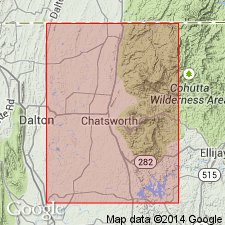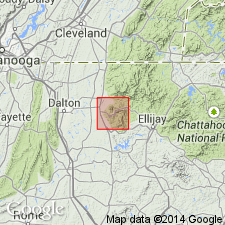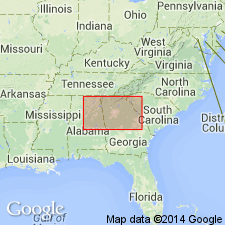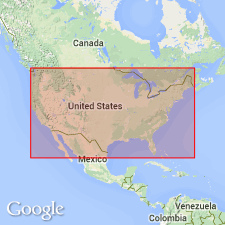
- Usage in publication:
-
- Fort Mountain gneiss
- Modifications:
-
- First used
- Dominant lithology:
-
- Gneiss
- AAPG geologic province:
-
- Piedmont-Blue Ridge province
Summary:
Thrust faults supplementary to the mapped overthrust, which separates the eastern crystalline block from known Paleozoic sediments of the Great Valley, bring up a Precambrian biotite augen gneiss, Fort Mountain gneiss, intruded by granite, upon which Ocoee rocks are unconformable. Talc deposits and associated schists, Cohutta schist, occur in upthrust block of Fort Mountain gneiss but not in the Ocoee series.
Source: GNU records (USGS DDS-6; Reston GNULEX).

- Usage in publication:
-
- Fort Mountain gneiss
- Modifications:
-
- Named
- Dominant lithology:
-
- Gneiss
- AAPG geologic province:
-
- Piedmont-Blue Ridge province
Summary:
Fort Mountain gneiss, as mapped, is a complex of igneous and metamorphic rocks that contains numerous bodies of Corbin granite and Cohutta schist. Intruded by Corbin granite. Derivation of name given.
Source: GNU records (USGS DDS-6; Reston GNULEX).

- Usage in publication:
-
- Fort Mountain Gneiss†
- Modifications:
-
- Abandoned
- AAPG geologic province:
-
- Piedmont-Blue Ridge province
Summary:
The Fort Mountain Gneiss of Furcron and others (1947) is abandoned. Its rocks are here assigned to the Corbin Gneiss of the Allatoona Complex, to which it is lithically identical. The two are in the same stratigraphic position and are the same age.
Source: GNU records (USGS DDS-6; Reston GNULEX).

- Usage in publication:
-
- "Fort Mountain Gneiss"
- Modifications:
-
- Overview
- AAPG geologic province:
-
- Piedmont-Blue Ridge province
Summary:
Used as "Fort Mountain Gneiss" because term was previously abandoned.
Source: GNU records (USGS DDS-6; Reston GNULEX).
For more information, please contact Nancy Stamm, Geologic Names Committee Secretary.
Asterisk (*) indicates published by U.S. Geological Survey authors.
"No current usage" (†) implies that a name has been abandoned or has fallen into disuse. Former usage and, if known, replacement name given in parentheses ( ).
Slash (/) indicates name conflicts with nomenclatural guidelines (CSN, 1933; ACSN, 1961, 1970; NACSN, 1983, 2005, 2021). May be explained within brackets ([ ]).

